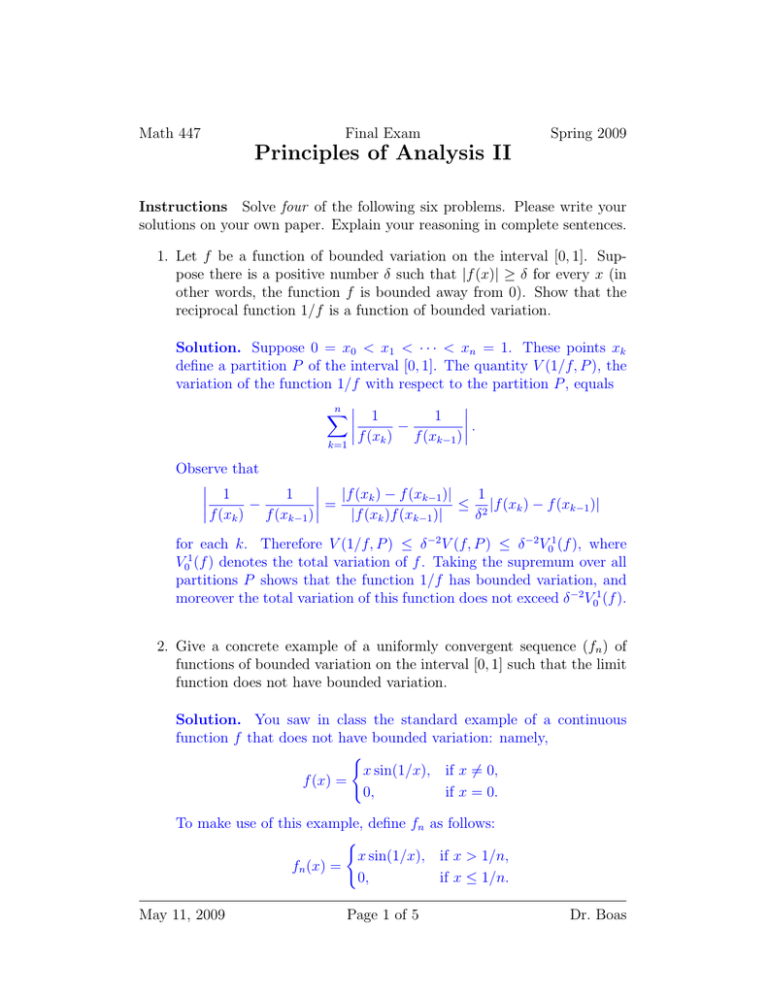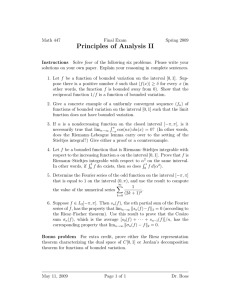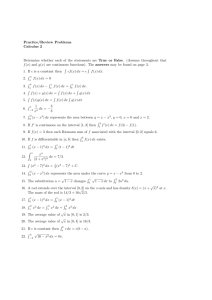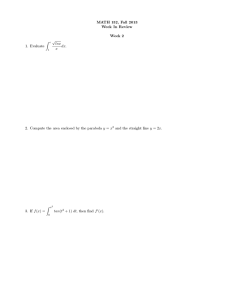Principles of Analysis II
advertisement

Math 447 Final Exam Spring 2009 Principles of Analysis II Instructions Solve four of the following six problems. Please write your solutions on your own paper. Explain your reasoning in complete sentences. 1. Let f be a function of bounded variation on the interval [0, 1]. Suppose there is a positive number δ such that |f (x)| ≥ δ for every x (in other words, the function f is bounded away from 0). Show that the reciprocal function 1/f is a function of bounded variation. Solution. Suppose 0 = x0 < x1 < · · · < xn = 1. These points xk define a partition P of the interval [0, 1]. The quantity V (1/f, P ), the variation of the function 1/f with respect to the partition P , equals n X 1 1 f (xk ) − f (xk−1 ) . k=1 Observe that 1 1 |f (xk ) − f (xk−1 )| 1 f (xk ) − f (xk−1 ) = |f (xk )f (xk−1 )| ≤ δ 2 |f (xk ) − f (xk−1 )| for each k. Therefore V (1/f, P ) ≤ δ −2 V (f, P ) ≤ δ −2 V01 (f ), where V01 (f ) denotes the total variation of f . Taking the supremum over all partitions P shows that the function 1/f has bounded variation, and moreover the total variation of this function does not exceed δ −2 V01 (f ). 2. Give a concrete example of a uniformly convergent sequence (fn ) of functions of bounded variation on the interval [0, 1] such that the limit function does not have bounded variation. Solution. You saw in class the standard example of a continuous function f that does not have bounded variation: namely, ( x sin(1/x), if x 6= 0, f (x) = 0, if x = 0. To make use of this example, define fn as follows: ( x sin(1/x), if x > 1/n, fn (x) = 0, if x ≤ 1/n. May 11, 2009 Page 1 of 5 Dr. Boas Math 447 Final Exam Spring 2009 Principles of Analysis II The function fn has bounded variation because the graph consists of finitely many bounded, monotonic pieces. (The number of pieces grows with n, however.) The sequence (fn ) converges uniformly to f because sup |fn (x) − f (x)| ≤ 1/n. 0≤x≤1 3. If α is a nondecreasing function R π on the closed interval [−π, π], is it necessarily true that limn→∞ −π cos(nx) dα(x) = 0? (In other words, does the Riemann–Lebesgue lemma carry over to the setting of the Stieltjes integral?) Give either a proof or a counterexample. Solution. For a counterexample, consider the step function α such that α(x) = 0 if x < 0, and α(x) = 1 if x ≥ 0. You know from class and from the homework exercises that StieltjesRintegration against this α acts like π a “delta function”: in other words, −π cos(nx) dα(x) = cos(0) = 1 for Rπ every n. Hence limn→∞ −π cos(nx) dα(x) 6= 0. Remark If α isRdifferentiable and hasR a derivative that is Riemann π π integrable, then −π cos(nx) dα(x) = −π cos(nx)α0 (x) dx [by Theorem 14.18 on page 232]; in this case, the limit of the integral is equal to 0 by the usual Riemann–Lebesgue lemma [equation (15.4) on page 248 or Theorem 19.17 on page 353]. 4. Let f be a bounded function that is Riemann–Stieltjes integrable with respect to the increasing function α on the interval [0, 1]. Prove that f is Riemann–Stieltjes Rintegrable with respect to αR2 on the same interval. 1 1 In other words, if 0 f dα exists, then so does 0 f d(α2 ). Remark added May 12 The solution below assumes that the function α2 is increasing, which need not be the case. [The function α(x) might be x − 1/2, for example.] There are a couple of ways to reduce to the situation in which α2 is increasing. 1. Either α is nonnegative (in which case α2 is increasing), or α is nonpositive (in which case α2 is decreasing, and −α2 is increasing), or there is a point c where α changes sign from negative to positive (in which case α2 is decreasing on the interval [0, c] and increasing on the May 11, 2009 Page 2 of 5 Dr. Boas Math 447 Final Exam Spring 2009 Principles of Analysis II interval [c, 1]). In the first case, the argument R 1 below 2applies. In the second case, the argument below shows that 0 f d(−α ) exists, and it R1 R1 follows from the definitions that 0 f d(−α2 ) = − 0 f d(α2R). In the c third case, use the preceding two cases to deduce that both 0 f d(α2 ) R1 R 1 and c f d(α2 ) exist; hence 0 f d(α2 ) exists. 2. Alternatively, observe that there is a constant k for which the function α + k is positive (any value than |α(0)| will do). The R 1 of k greater 2 argument below implies that 0 f d((α + k) ) exists. It is routine to see R1 R1 that existence of 0 f dα implies existence of 0 f d(2kα + k 2 ) [which R1 R1 R1 equals 2k 0 f dα], and the difference 0 f d((α+k)2 )− 0 f d(2kα+k 2 ) R1 equals 0 f d(α2 ). Solution. Fix an arbitrary positive ε. The integrability of f with respect to α implies (by Riemann’s condition) that there is a partition P such that the upper sum Uα (f, P ) and the lower sum Lα (f, P ) differ by less than ε. In other words, there is a subdivision of the interval [0, 1] into n subintervals [xk−1 , xk ] such that if Mk and mk denote the supremum and the infimum of f on [xk−1 , xk ], then n X (Mk − mk )[α(xk ) − α(xk−1 )] = Uα (f, P ) − Lα (f, P ) < ε. k=1 The goal is to estimate the difference between upper and lower sums with respect to α2 . The function α is increasing, so α(xk )2 −α(xk−1 )2 = [α(xk ) − α(xk−1 )][α(xk ) + α(xk−1 )] ≤ 2α(1)[α(xk ) − α(xk−1 )]. Therefore n X Uα2 (f, P ) − Lα2 (f, P ) = (Mk − mk )[α(xk )2 − α(xk−1 )2 ] k=1 ≤ 2α(1)[Uα (f, P ) − Lα (f, P )] ≤ 2εα(1). Since ε is arbitrary, Riemann’s condition implies that f is integrable with respect to α2 . 5. Determine the Fourier series of the odd function on the interval [−π, π] that is equal to 1 on the interval (0, π), and use the result to compute ∞ X 1 . the value of the numerical series (2k + 1)2 k=0 May 11, 2009 Page 3 of 5 Dr. Boas Math 447 Final Exam Spring 2009 Principles of Analysis II Solution. P The Fourier series of an odd function is a sine series of the form ∞ n=1 bn sin(nx). For the specified function, π Z 2 π 2 − cos(nx) bn = 1 · sin(nx) dx = π 0 π n 0 ( 4 , if n is odd, 2 [− cos(nπ) + cos(0)] = nπ = nπ 0, if n is even. Writing an odd integer n in the form 2k + 1 shows that the Fourier series has the form ∞ X k=0 4 sin[(2k + 1)x]. (2k + 1)π According to Parseval’s equation, the sum of the squares of the Fourier coefficients equals 1/π times the integral of the square of the function over the interval [−π, π]. Thus ∞ 1 2 16 X = 2 2 π k=0 (2k + 1) π Z π 2 1 dx = 2, 0 so ∞ X k=0 1 π2 = . (2k + 1)2 8 Remark You summed this series using a different Fourier series in Assignment 8. 6. Suppose f ∈ L2 [−π, π]. Then sn (f ), the nth partial sum of the Fourier series of f , has the property that limn→∞ ksn (f )−f k2 = 0 (according to the Riesz–Fischer theorem). Use this result to prove that the Cesàro sum σn (f ), which is the average [s0 (f ) + · · · + sn−1 (f )]/n, has the corresponding property that limn→∞ kσn (f ) − f k2 = 0. Solution. Fix an arbitrary positive ε. By the Riesz–Fischer theorem, there is a positive integer N such that ksk (f ) − f k2 < ε/2 when k ≥ N . May 11, 2009 Page 4 of 5 Dr. Boas Math 447 Final Exam Spring 2009 Principles of Analysis II Thus when n > N , the definition of σn (f ) implies that [s0 (f ) − f ] + · · · + [sn−1 (f ) − f ] kσn (f ) − f k2 = n 2 N −1 n−1 X X 1 1 ksk (f ) − f k2 + ksk (f ) − f k2 ≤ n k=0 n k=N N −1 ε 1X ksk (f ) − f k2 . < + 2 n k=0 Since N is fixed (dependent on ε but not on n), the second term in the third line of the displayed formula will be less than ε/2 when n is sufficiently large. Hence kσn (f ) − f k2 < ε when n is sufficiently large. Therefore limn→∞ kσn (f ) − f k2 = 0. Bonus problem For extra credit, prove either the Riesz representation theorem characterizing the dual space of C[0, 1] or Jordan’s decomposition theorem for functions of bounded variation. Solution. We did these proofs in class, and there are proofs in the book too (pages 237–239 and 207). May 11, 2009 Page 5 of 5 Dr. Boas







